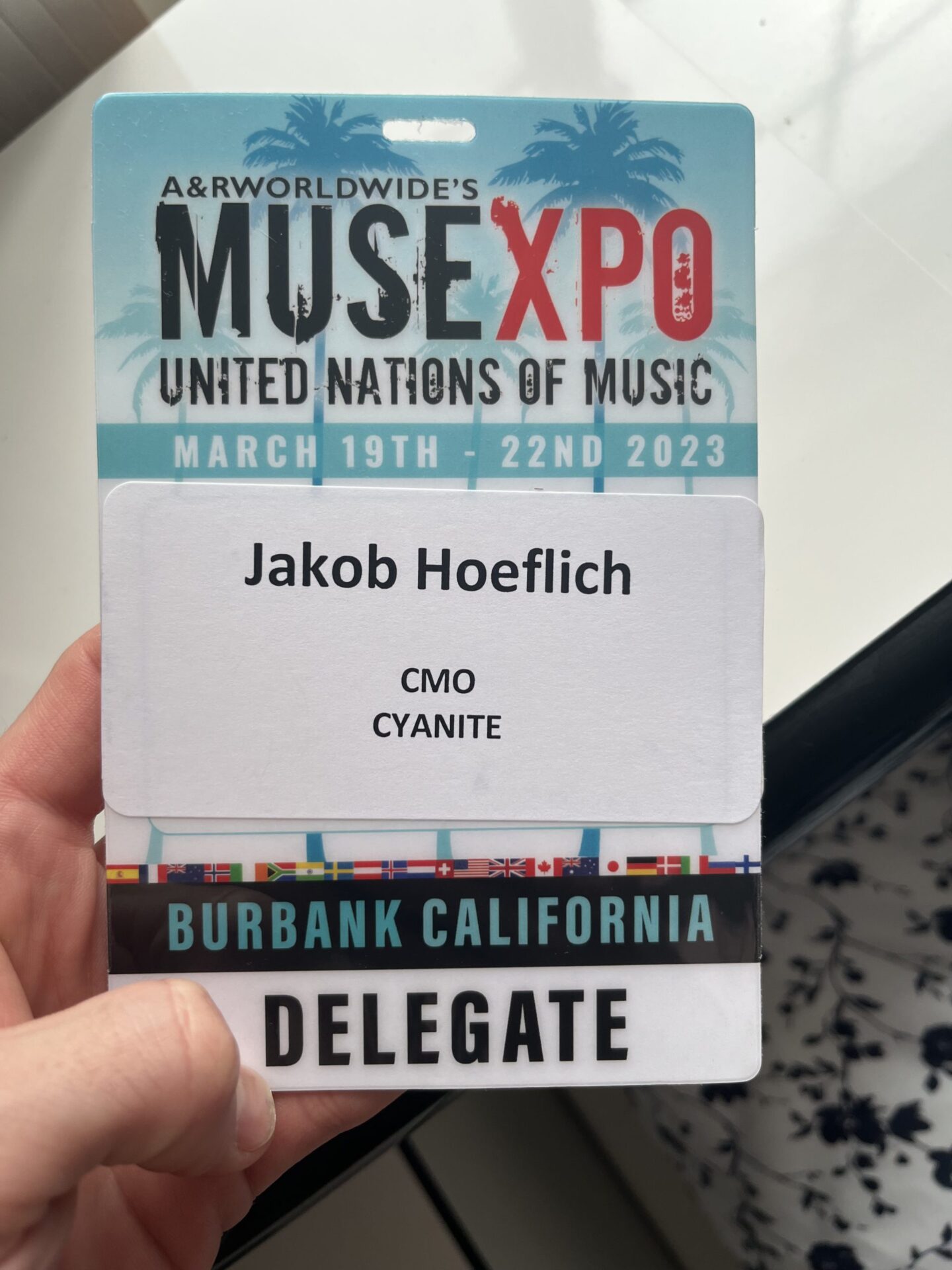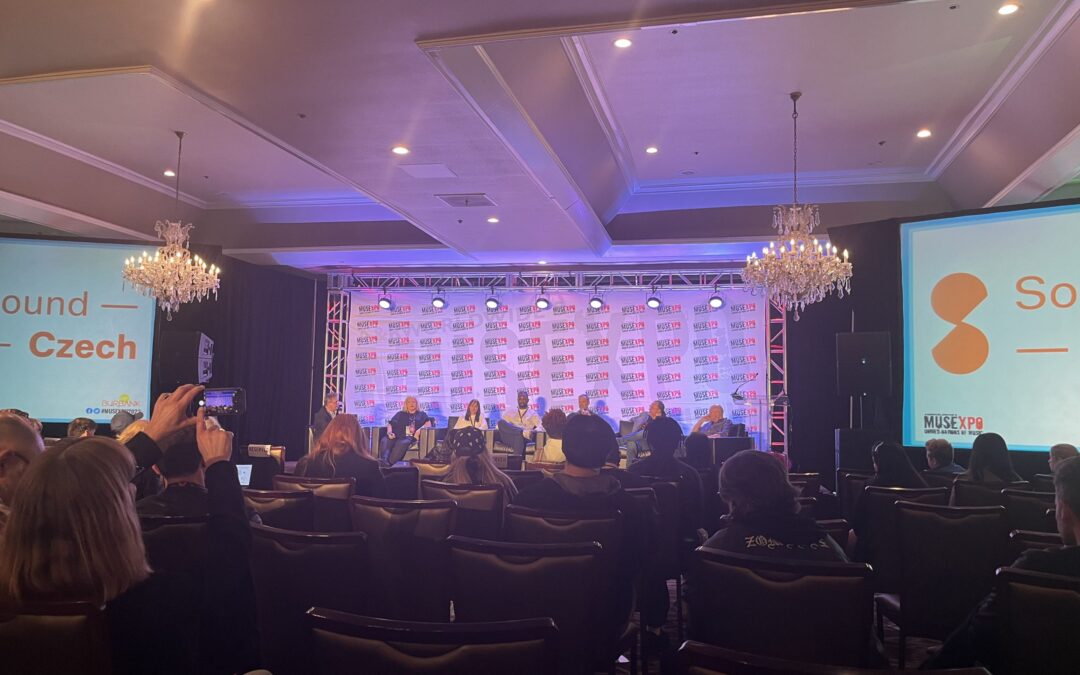Last updated on November 3rd, 2025 at 05:11 pm
Written by our CMO Jakob Höflich
I just came back to Berlin after visiting this year’s Musexpo on behalf of Cyanite after Covid closed the event down in 2020, when we originally planned to attend.
It was a four-day event packed with panels featuring some of the industry’s leading figures such as Adam Taylor (President APM Music), Evan Bogart (Founder & CEO, Seeker Music) and Kristin Graziani (President Stem Disintermedia Inc. ) as well as evening showcase performances at iconic S.I.R. Studios Hollywood by an international group of artists such as Caity Baser from the UK or Holly Riva from Australia. My first eye opener was when the German band KAMRAD played their hit song “Believe” on the first night of the showcase, which I definitely knew from radio and has been listened to over 70 million times on Spotify, but is still completely unknown in the American market. It made me realize again how isolated Western music markets can still be.
The panels were mainly about “traditional” craft in the areas of sync, publishing, artist promotion and distribution. In addition, many artists had the opportunity to meet supervisors and A&Rs. Technology topics such as AI, NFTs and the Metaverse were not represented in the panel topics. However, on the panels themselves and in the audience Q&A, AI was a recurring topic brought up. Of course, as an AI company, I would have liked to see a bit more tech talk, but on the other hand, it was interesting to approach these topics from the “inside out”.
One thing that’s always refreshing to see is that everyone puts on their trousers one leg at a time. The challenges of mass content production, an extremely decentralized media and distribution landscape, and the future of creativity in the age of AI were topics to which no one had a perfect answer or a concrete solution. The challenges are obvious, and it became very clear at a conference like this that these challenges can only become solutions that benefit all players equally if they are worked on together and a dialog is cultivated between the music industry, artists and technology providers – as Cherie Hu recommends as well in this article.
Besides meeting really inspiring and genuine people in person, such as a leading NASA researcher turned music composer, here are the main take aways, that I brought back to Germany and that were interesting to see addressed.
Before I start, a huge thanks to Sat Bisla and his team who put together a fabulous event and provided a setting in which new and old relationships can evolve, nurture, and deepen.
Without further ado, here are my personal key take-aways – of course, there was much more and I won’t be able to cover the whole scope of the conference.
It’s noisy and crowded
The conference started off with taking a look at the industries most pressing problems and opportunities. It directly became clear that the biggest challenge for all players involved is the masses of content and the numerous outlets for them. It was said that “it is freedom and chaos at the moment“. It’s extremely hard to cut through the noise and in contrast to the times when there was MTV and your local record shop to distribute music, it is an extremely individualized case by case decision about which target groups to focus on, where to reach them, and what kind of content to produce for them.
Also, everything comes with lots of new challenges for artists who were often called “brands“ at the conference. Artist development is more and more in the hands of the artist themselves (and their teams) as the big players in particular focus on placing bets on single hits that often dominate today’s streaming landscape. However, it is said that fans engage with artists, not with songs, and that is where true fandom is created.
Lots of question marks in this space of freedom and chaos evolve around TikTok and Co. and how those platforms will be able to set up fair royalty payouts. And as we shift to poorly-paid licensing models such as Tiktok, artist teams need to find new revenue streams.
The importance of back catalog & sync
There were a couple of really amazing panels around sync, publishing, and music supervision. The Hello Group’s President Phil Quartararo said in the opening panel: “People have unlearned to work their back catalog“ and have forgotten how to maximize the use of it. And he subtly but directly addressed the majors with this statement. Apparently, the majors are so focused on breaking new artists and “going where the money is“, that they forget about all the brilliant music that’s in their back catalogs. According to him, the industry should pay more focus on the dusty corners of the catalogs where the real gems can be very well hidden.
What also became clear, that despite the fact that access to music has become so easy, the access to the influential people who recommend your music to the music directors at Netflix et al. or at the most influential radio stations, create a very tough bottleneck to pass through. Both radio stations and music supervisors have their so-called ”trusted sources“ that not only provide them with music that could work amazingly well in sync, but from whom they also know that they make sure that the music is easy to clear.
One thing that I found mind-blowing is that supervisors apparently often prefer to take older music where the rights don’t have to be cleared from 15 co-writers but maybe just 2 or so. Contemporary music takes more time to clear the breadth of songwriters that were involved. This is another motivation to all songwriter out there to pay meticulous attention to clean and neat metadata!
Last but not least, commercial music only produced to get attention in sync, is not really favored by supervisors. Yes, it can be a great fit sound-wise but the initial motivation might reveal a lack of authenticity. And authenticity is what supervisors are looking for when they connect music with movie productions and especially with brands. Here, again, people engage with the people behind the songs, not only the songs themselves.
More insights tomorrow in Part 2 on AI, data and the internationalization of the music industry.



